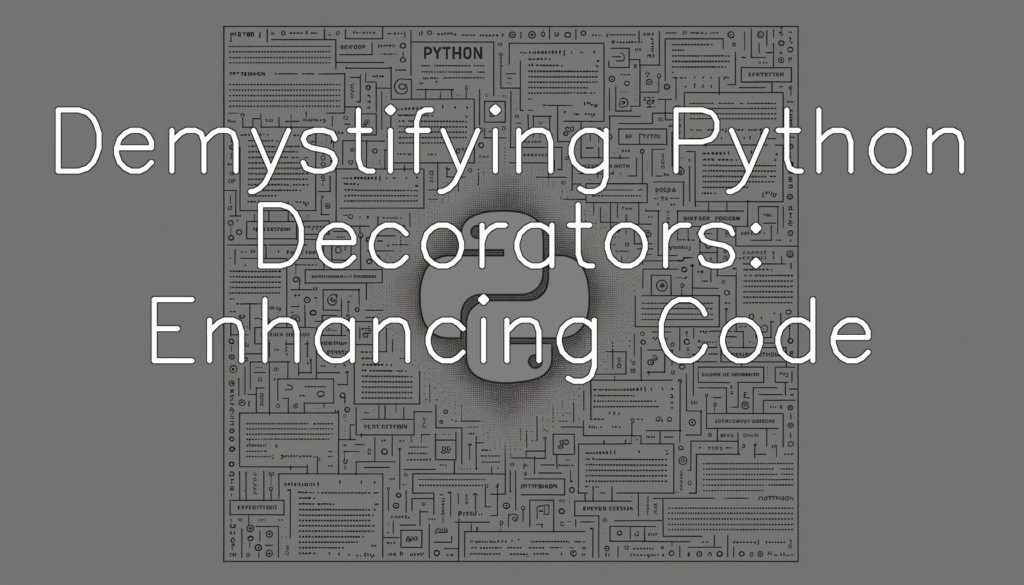Understanding Python Decorators: A Brief Overview
Python decorators, in essence, have the ability to modify or enhance the functions or methods in your code, adding to its functionality and elegance without having to alter the source code directly. This feature, inherent to Python, offers programmers a way to wrap a function or method with another function, expanding its capabilities in a way that’s both efficient and elegant. This Python magic allows developers to scale and customize solutions quickly, making it highly sought after in modern programming especially in the context of cloud services. In this brief overview, we wish to shed light on this oft-understood yet powerful feature of Python – decorators.
Importance of Python Decorators in Enhancing Code Functionality
Programming in Python often involves writing functional and concise code, and Python decorators play an instrumental role in achieving this by enhancing code functionality. They allow developers to modify the behavior of a function or class without changing its source code, thereby promoting code reuse. This proves particularly beneficial when you need to add functionality that is needed in many different parts of your code, such as logging, access control, rate limiting, and caching. By using Python decorators, you can add these functionalities just once in a decorator and then apply it to any function that requires it. This way, decorators contribute to the elegance of the code by ensuring it remains DRY (Don’t Repeat Yourself) and uncluttered, making it not only more efficient but also more readable and maintainable.
Python Decorators: Diving Deeper
What are Python Decorators?
Python decorators are essentially a very powerful, yet often misunderstood, advanced feature of the Python language. At their core, decorators are a way to modify or enhance functions or methods in a Python program without changing their source code. They achieve this by wrapping another function, thereby extending or completely replacing the behavior of the wrapped function. While the concept might seem intricate initially, understanding decorators is key to making the most of Python’s capabilities.
The Role of Python Decorators in Code Enhancement
As the name suggests, Python decorators add decoration to your code – but in this context, decoration equates to an enhancement in functionality. At their core, they are a powerful tool that allows for the modification of the behavior of a function or class without necessarily altering its source code. This enables developers to incorporate new functionalities to an existing object without any large-scale changes. The result? Simplified code that adheres to the principles of code reusability and readability. Python decorators cater to the ‘don’t repeat yourself’ principle of coding, allowing for a cleaner and more elegant approach to programming. Not just that, they can also improve the debugging process by providing helpful inputs about the function’s activity, proving their essential role in enhancing Python code functionality.
Working with Python Decorators
Python Decorators: Basic Syntax and Usage
Python Decorators essentially have a simple syntax that is easy to comprehend and use. Fundamentally, a decorator in Python is a function that takes another function as an argument and augments its functionality or behavior without explicitly changing it. Decorators are called using the “@” symbol followed by the decorator name just before defining the function that has to be decorated. This “@” symbol is just syntactic sugar and the process of decorating a function can be done without it, but it helps in making the code easier to read and understand. It’s like wrapping a present; the original function gets augmented with additional features, but its core essence remains untouched. This simple yet powerful concept gives Python an elegant way to enhance your code functionality with minimal changes.
Detailed Explanation: Creating and Using Python Decorators
In essence, creating and using Python decorators involves wrapping one function with another, rules which allow coders to tangibly modify or enhance the behavior of existing code without actually changing it. To begin with, the decorator is positioned above the function it is set to enhance or modify. Defining a decorator involves creating a function that accepts another function as input, and returns an entirely new function that typically includes the input function and more, thereby changing its behavior. In terms of usage, decorators come into picture when there’s a need to add functionality to an existing bit of code, and is not required to incorporate this additional functionality directly into the code. This can be helpful in keeping the code clean and organized. The real beauty of Python decorators is that they can be used to enhance or modify any function or method, bringing in a level of flexibility and dynamism that can significantly streamline code development workflows.
Code Examples: Utilizing Decorators to Improve your Python Code
Let’s dive into how decorators can enhance your Python code with a basic example. Consider a situation where you have a function ‘greet()’ that greets the user. But what if you want to enhance its functionality so that it also tells the user what time they are greeted without modifying ‘greet()’? Here, decorators come in handy. You would create a decorator function, say ‘add_time()’, that takes ‘greet()’ as an argument and modifies it to include time before greeting the user. Now, simply by adding ‘@add_time’ before the ‘greet()’ definition, you’re telling Python to apply the ‘add_time()’ decorator to the ‘greet()’ function. So when ‘greet()’ is called, it’s passed through the ‘add_time()’ letting Python know “It’s time to enhance this function!” The beauty of this is that it’s reusable across multiple functions, and each function’s core functionality remains uncoupled from its enhancements.
Advanced Concepts of Python Decorators
Exploring the Possibilities with Python Decorators
Despite their simplicity, Python decorators open up a world of possibilities, enabling us to implement an infinite variety of use cases. New patterns of code structure and design can be discovered by mastering decorators. They can manipulate the way functions behave, add new functionalities, or tweak an existing function to suit a specific need without altering its source code, thereby enhancing modularity and code reuse. The real power of decorators lies in their ability to transform our code in an elegant, readable, and efficient way. They can be used to time the execution of functions, retry operations, rate-limit functions, create singleton classes, and much more.
Advanced Techniques for Using Python Decorators in Cloud Services
Python decorators are not only powerful but flexible, opening up a plethora of advanced usage possibilities especially in the realm of cloud services. For instance, in cloud-based development, decorators can be used to execute functions across servers without modifying the function itself. This makes the deployment of software and coordination of microservices significantly easier. Decorators can also assist in logging and tracking function calls, vital in cloud computing as it ensures the smooth execution of diverse commands across numerous platforms. Moreover, Python decorators allow for authentication checks to be integrated into function calls, a critical aspect in maintaining security in cloud systems. These advanced applications showcase how Python decorators can facilitate enhanced control, security, and efficiency in cloud service ecosystems.
Improving Code Elegance with Python Decorators: Real-world Use Cases
In today’s competitive programming world, not only the functionality of the code matters but also how elegant and clean your code looks. This is where Python decorators steal the show. They are a powerful tool that allows the programmers to modify and enhance the functionality of methods and class in a clean and efficient way, ensuring that the code remains DRY (Don’t Repeat Yourself) and easy to read. Real-world use cases of decorators can be seen in various software applications such as Django, Flask, and even in Python’s in-built functions. For instance, in the Flask web framework, decorators like ‘@app.route’ are used to bind a function to a URL. Hence, utilizing decorators enhances coherence and readability, thus improving the overall code elegance.
Conclusion
In conclusion, Python decorators play a critical role in enhancing code functionality and maintaining elegance. Their versatility and effectiveness are increasingly reshaping the way we approach Python coding, irrespective of the complexity of the tasks. By providing an intuitive and efficient way to modify function or class behavior, decorators open a world of possibilities for creating elegant and reusable code. Looking into the future, the adoption of decorators promises to increase given their critical role in easy-to-maintain, scalable, and robust code development. Whether you are an experienced Python programmer or a beginner, incorporating Python decorators would certainly steer you towards achieving professional and highly maintainable coding standards.





